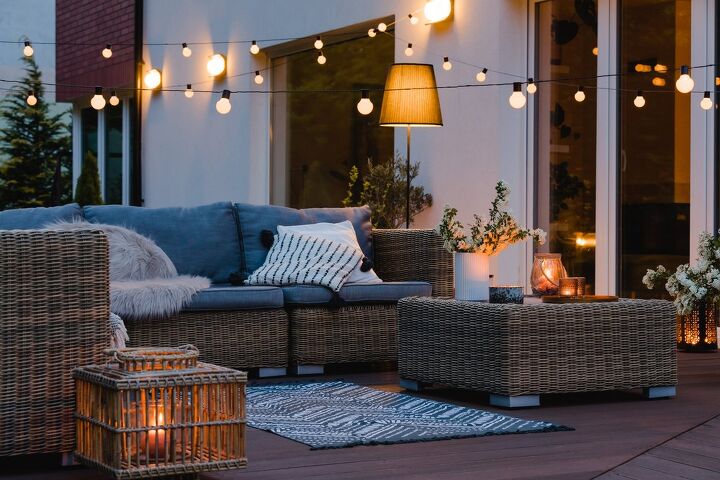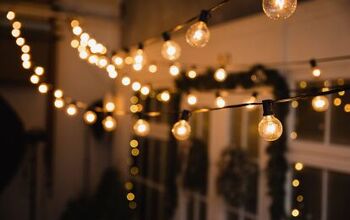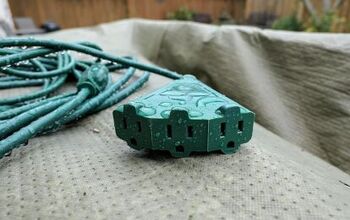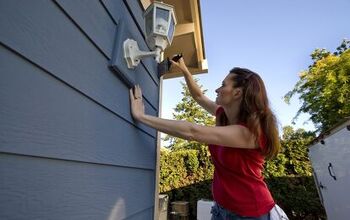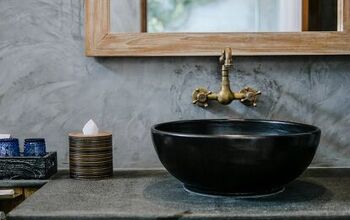Can You Use Indoor Lights Outside? (Find Out Now!)

When lighting up your home, dozens of fixtures are available for both outdoor and indoor use. When installing the lights, you should pay attention to whether they are for outdoor or indoor use. But, one question always comes to mind; can indoor lights be used outdoors safely?
You can use indoor bulbs and other lighting fixtures for your outdoor living spaces. However, it’s best to remember that most indoor lighting fixtures are not designed for outdoor use. For starters, they are not sealed against moisture, and therefore, are likely to stop working as soon as it rains. Besides, some fixtures aren’t corrosion resistant. Hence, they can quickly become an electrocution hazard if their parts start to corrode.
Before you use an indoor lighting fixture outdoors, you should first determine whether it can withstand the elements. An easy way to do so is by determining its UL rating for damp, wet, and dry locations and its ability to withstand outdoor temperature changes.
Do You Need to Hire an Electrician?
Get free, zero-commitment quotes from pro contractors near you.

Differentiating Indoor Lights from Outdoor Lights
Today, most lighting fixtures are designed for both outdoor and indoor use. Finding such fixtures will save you a lot of hassle because you won’t have to worry about using them interchangeably. However, the same cannot be said of lighting fixtures designed explicitly for indoor or outdoor use.
It would help if you knew the difference between outdoor and indoor lights. This way, you won’t run into any avoidable problems that could be caused by using the wrong lights for your indoor and outdoor living space. That said, you should have an idea about the types of light bulbs that can be used outdoors, indoors, or both. Here’s an overview of what you need to know:
- LED lights: These can be used for both outdoor and indoor lighting.
- Compact fluorescent light bulbs: You can use these both indoors and outdoors. Nevertheless, check the optimum temperature of the bulbs before you install them outdoors.
- Incandescent flood light bulbs: These can be used outdoors and indoors if they are not in contact with moisture. Incandescent flood light bulbs are created to withstand the elements and are ideal for outdoor use.
Generally, indoor lighting fixtures are designed for use in dry spaces inside your home. They include kitchens, hallways, dining rooms, and bedrooms. The indoor light fixtures are designed for damp locations or transitional outdoor/indoor spaces. Some of them include laundry rooms, bathrooms, spas, and pool rooms. These fixtures are often UL-rated, and therefore, can also be used outdoors without any problems.
Most indoor lighting fixtures are not UL-listed. This means they are not suitable for installation in wet areas, including your outdoor living spaces. The fixtures are not built to withstand adverse weather such as rain and snow. So for safety reasons, you should avoid using them outdoors.
Safety Tags on Outdoor vs. Indoor Lights
An important consideration when using indoor lights outdoors is their safety tags. According to the Underwriters Laboratories (UL), a lighting fixture can only be deemed safe for outdoor use after being inspected and proven safe from fire and shock.
Before you use an indoor light bulb outdoors, you should ensure it’s UL listed. You can ascertain this by checking for the UL tags on the cords. If you use an indoor lighting fixture that isn’t UL-rated outdoors, you run the risk of electrocution or even fires in your home.
Indoor bulbs that are UL-rated feature silver or green tags with the word ‘UL’ written in silver or red. Therefore, if you have bulbs or light strings from previous years and you can’t tell whether they are safe for indoor use or not, it’s best to check for the UL tag. If the tag is missing, don’t take the risk. Instead, we only use the strings/bulbs indoors.
Does Size Matter?
Although size isn’t the rule of thumb, it can help you determine whether a lighting fixture is meant for indoor or outdoor use. Generally, lighting fixtures designed for outdoor use tend to have bigger and stronger bulbs than those meant for indoor use. Find out how how to hang Christmas lights outside without nails.
Can Indoor and Outdoor Lights Be Used interchangeably?
Now that you know how to differentiate indoor lights from outdoor lights, you may find yourself asking whether they are interchangeable. There’s no straight answer to this question because it all depends on where you want to use the bulbs.
Generally, certain types of bulbs can be used both indoors and outdoors. Before using indoor lights outside, always ensure that they are weather-resistant. It’s much easier to use in outdoor light indoors, especially in transitional spaces such as sheltered porches.
In most cases, those who use outdoor lights indoors do it to add a unique style to their living spaces. This is often an outstanding design choice for indoor spaces. Given that these light fixtures are built to withstand extreme outside conditions, installing them indoors shouldn’t be a problem.
Nonetheless, it’s essential to consider the energy consumption of these lights before using them interchangeably. Outdoor lights tend to consume more energy than indoor lights and vice versa. The output of indoor and outdoor lights also varies, and therefore, this should be a key consideration if you’re thinking about using indoor lights outside.
Indoor Lights and UL Listings
As mentioned earlier, the most effective way to tell whether a light bulb is suitable for indoor or outdoor use is by checking its UL rating. The Underwriters Laboratory has specific ratings for particular locations.
UL Listing for Dry Locations
According to the UL listing, dry locations include indoor areas that aren’t typically subject to dampness. This could include sites that experience temporary dampness but are adequately ventilated to prevent the accumulation of moisture. These locations include living rooms, bedrooms, dining rooms, foyers, and kitchens.
UL Listing for Damp Locations
Only light bulbs that are marked “Suitable for Damp/Wet Locations” should be used outdoors. Damp locations include exterior or interior spaces that periodically or normally get subject to moisture condensation. These include pool rooms, utility rooms, and bathrooms.
Outdoor locations that are listed as damp include covered patios and porches. If you have to use indoor lights in these locations, ensure they are UL-rated for use in damp locations. This will go a long way in minimizing the risk of corrosion and electrocution.
Find out if indoor lights can be solar charged.
UL Listing
Just like it’s the case with the UL listing for damp locations, only lighting fixtures marked “Suitable for Wet Locations” should be used in wet locations. These are locations where water drips, splashes, or flows and include walkways, outdoor dining areas, and uncovered porches. If a lighting fixture has the UL rating for use in suitable locations, you can install it anywhere in your outdoor spaces without any worries.
Indoor Lights and Outside Temperature
Apart from the UL listing for safety around water, the ambient temperature is another critical consideration for determining the suitability of using indoor lights outside. Typically, indoor lights get exposed to a more limited temperature range compared to outdoor lights.
An indoor lighting fixture doesn’t get exposed to extremely hot or cold temperatures because room temperatures tend to be constant. Conversely, outdoor bulbs and other lighting fixtures tend to get exposed to a broad range of temperatures and the fluctuations that come with them.
If you’re thinking about using indoor lights outside, you must remember that they will get exposed to freezing temperatures. Fluorescent lights, in particular, are likely to flicker or start slowly in extreme cold.
Often, these issues start to show when temperatures drop below freezing point. Even so, there are newer types of indoor bulbs designed to withstand extremely cold temperatures. These would suit you if you still want to go ahead with your plan to use indoor lights outdoors.
LED lights work excellently even in cold weather. If you use LED lights in your outdoor spaces, you’ll notice that they tend to shine brighter in extremely cold weather. Besides, they are also likely to be more energy-efficient. Therefore, you can use indoor LED lights in your outdoor spaces without any problems.
Generally, heat is a great impediment to LED lights. These lamps generate heat in their base when in use. Constant airflow is needed to keep the bulbs cool and ensure they work optimally. This explains why LED lights work best when ambient temperatures are low.
Most outdoor wet listed bulbs and lighting fixtures come tightly enclosed to ensure water resistance. However, this can be a problem with LED lights, especially during the hot months of the year. Overheating could cause the LED bulbs to be not only less efficient but also burn out faster.
Do You Need to Hire an Electrician?
Get free, zero-commitment quotes from pro contractors near you.

Key Takeaways
Whenever lighting fixtures at your home need replacing, it’s always good practice to consider whether the replacement unit is built for indoor or outdoor use. Generally, outdoor lighting fixtures can be used indoors, but that doesn’t always apply to indoor lighting fixtures.
Before installing an indoor lighting fixture outdoors, it’s best to consider its UL rating and ability to withstand the typically extreme outside temperature. This is the surest way to optimize light’s lifespan and minimize the risk of electrocution and similar misfortunes.

We are a team of passionate homeowners, home improvement pros, and DIY enthusiasts who enjoy sharing home improvement, housekeeping, decorating, and more with other homeowners! Whether you're looking for a step-by-step guide on fixing an appliance or the cost of installing a fence, we've here to help.
More by Upgraded Home Team



